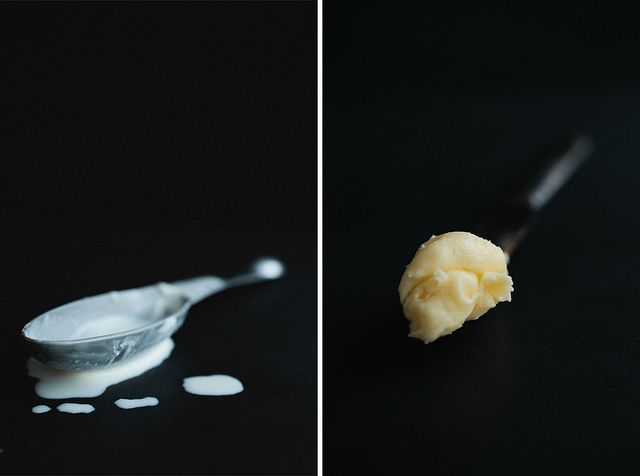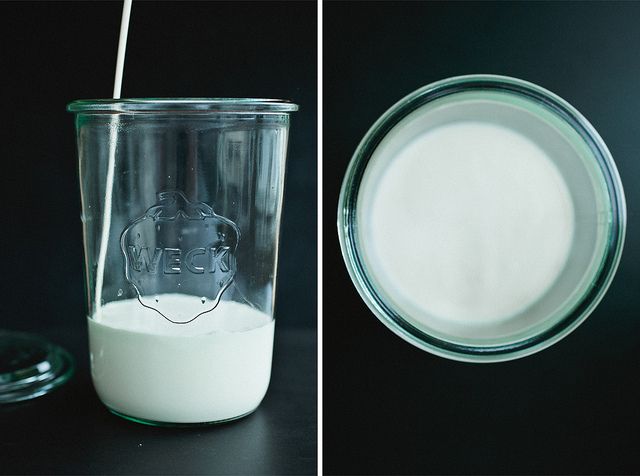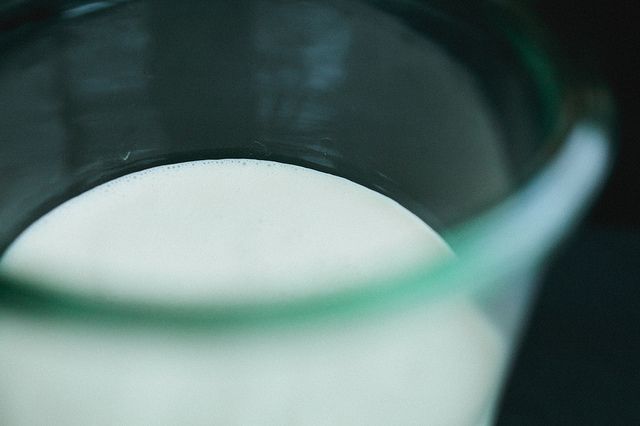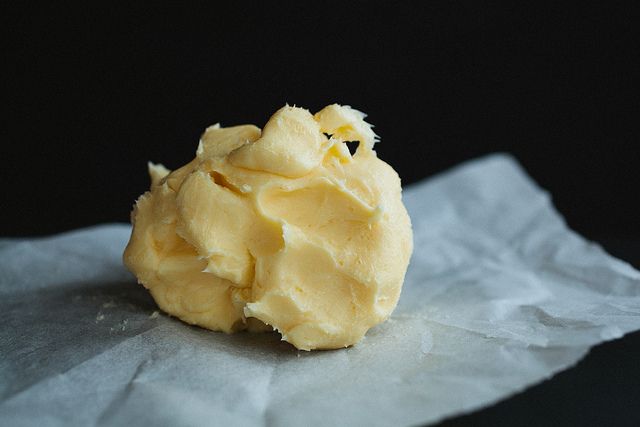Popular on Food52
Continue After Advertisement
27 Comments
Nancy R.
December 24, 2012
I do not think it will work with yogurt the reason it works with heavy cream is because you are separating out the solid butter from the cream the remaining whey liquid is very thin I add it to bread. I have never tried yogurt, I am not sure there is anything to separate out to change the main ingredient into butter. Does anyone Know?
Panfusine
December 24, 2012
In India, yogurt has always been set at home , and is available commercially on a large scale only in the recent years. SInce the milk had plenty of cream, when set, the cream forms a 'creme fraiche' like layer over the yogurt. This thick layer was skimmed off, accumulated over a couple of days in the refrigerator and was then churned to make butter. Perhaps this is where the reference to Yogurt comes from.
Hina K.
December 24, 2012
Oh I know about the necessity of using cream...I was talking about the step where you add 2 tablespoons of plain yogurt to the cream...I wasn't sure if Greek yogurt instead of plain yogurt would work since Greek yogurt does have some slightly different properties than regular plain yogurt.
Panfusine
December 24, 2012
I'm pretty certain it wd work..Greek yogurt is definitely closer in flavor to the Indian Dahi (unless the whey part of the regular yogurt is crucial to that step)
Galapagos
December 26, 2012
Yogurt, Greek yogurt, cultured buttermilk, creme fraiche... any milk product with active culture of Lactobacillus should work as the inoculum of lactose-fermenting microbes that create the sour taste desired in the cultured butter. The Lactobacilli metabolize the sugar (lactose) in the cream to lactic acid.
Panfusine
April 17, 2012
I combined the cream & buttermilk & whipped it in a blender with a LOT of ice. At some point, the mixture turns from a creamy viscous liquid into blobs & dilute butter milk..aggregate the blobs & you get your butter. I leave the buttermilk out to 'sour' overnight & use it for traditional Indian stews.
inthebow
April 2, 2012
I made this with my 5-year-old son and it was so easy and tastes fantastic! He wanted to eat the butter like batter, and well, he did. Thanks so much!
Vivilicious
March 26, 2012
Hi Ashley, love the idea of making my own butter, but I assume you need cream that has not been ultra-pasteurized? Hard to get the good stuff here in Singapore ;-(
Kitchen B.
May 11, 2012
I make my own butter in Nigeria,...with pasteurised cream and its better than all the store-bought brands I've tried. I always finish with a pinch of salt....heaven!
teamom
March 25, 2012
At home, we do the typical European thing - line a container with an aromatic, and let the butter develop in it. The Herb Society of America has declared 2012 the Year of the Rose. Line a ceramic pot with unsprayed rose petals, and pack the butter into it. Cover, and let it mellow.
Last year's herb was horseradish, so I lined the container with horseradish leaves. Heaven. I don't add salt to the butter, it can always be added later (salting butter is just a preservative method).
Very good basic recipe!
Last year's herb was horseradish, so I lined the container with horseradish leaves. Heaven. I don't add salt to the butter, it can always be added later (salting butter is just a preservative method).
Very good basic recipe!
Nancy R.
March 25, 2012
Loved your butter recipe. I have been making butter at home for years with non ultra pasturized heavy cream. It goes well with fresh baked beread. It can also be flavored I use honey and freshly grated orange rind with my cinnamon nut swirl bread. And crushed garlic, minced basil and and chives to go with my french bread and rolls. For xmas every year I crush cranberry with the ornage rind and add a bit of honey made at least a day haead of time they are delicious. I have also made speciality butters for fish and other dishes.
Ashley R.
March 22, 2012
Thanks for all the lovely comments! So glad you all are as excited as I am about homemade butter. If you are doing the shaking method it will take about 10 minutes of shaking - depending on how many breaks you take in the process. Think of it more of smacking the cream against the side of the jar as shaking. You want to beat all the fat together. As soon as the buttermilk separates from the butter pour it off and continue shaking until very little buttermilk is produced. Rinse as in the directions above.
I've found homemade butter keeps for at least a week, covered in the fridge. I'm sure you can easily freeze it although I haven't tried.
I've found homemade butter keeps for at least a week, covered in the fridge. I'm sure you can easily freeze it although I haven't tried.
Kitchen B.
May 11, 2012
Hi Ashley, I don't rinse my butter with water - I'll give that a go next time but I do freeze it and it freezes beautifully. My friends are so intrigued that I make my own butter....I keep saying just how easy it is!
sianbum
March 22, 2012
For people with experience shaking their butter, about how long(ish) are we talking here?
withinseason
April 17, 2012
This depends a lot on your cream. I use non-homongenized, raw cream and it can vary from just a few minutes to over 10. After trying it in the food processor, that's what I always do now. Much easier to clean up afterward and really effective.
BlueKaleRoad
March 22, 2012
I can't wait to make this butter! When my kids were little we made butter with the jar-shaking method. Adding some culture sounds divine! I often wish I had a cow in our backyard...dogs and chickens will suffice, though.
lastnightsdinner
March 22, 2012
Love this. I haven't made butter at home in ages (I usually culture mine overnight, and I use the food processor instead of a hand/stand mixer, because it's faster and I'm impatient :) ) I think I need to make some again soon!
healthierkitchen
March 22, 2012
I made butter using the shake method back when I was in kindergarten for a Thanksgiving celebration and then did it at my daughter's Colonial themed (yes we're geeks) 7th birthday party. I've also done it a couple of times at a colonial reenactment park near us where each of my kids spent an overnight as part of their third grade curriculum, and I was one of the cooking helpers. It is something to see the butter come together! It really made an impression on me when I was 5!
mcs3000
March 22, 2012
Made butter before but not like this - looking forward to trying this recipe. Ashley, did you take the pics too? They pop off the page. Gorgeous!
BavarianCook
March 21, 2012
Awesome. Thank you! This will be on my list of fun things to do this weekend!!
arielleclementine
March 21, 2012
loved this article, and can't wait to try the recipe! completely agree about the daydream of living off the land. i think it started when i read The Boxcar Children as a little kid...
laurend
March 21, 2012
this sounds awesome and i can't wait to try making some myself! question though...i don't use lots of butter usually. what would the shelf life be like on this homemade version? and would freezing it totally kill it? thanks!
Panfusine
March 21, 2012
It was the default way of making butter for most households in India. The procedure was a bit different though. Full Fat milk would be set into yogurt and in the process the cream that rises to the top forms a thick layer. This layer would be skimmed off from the refrigerated yogurt, (it would just cleanly separate from the yogurt), in the freezer /fridge while more was added from subsequent yogurt sessions. The collected cream would then be whipped with some chilled water to release the butter. the remaining tart buttermilk would be used up in stews & soups.
annemai
March 21, 2012
I've done the shake method in a jar with my kids -- as well as a classroom full of 1st graders. Each child took a turn shaking the jars as part of a larger lesson on Thanksgiving. They loved the idea of making butter -- it opens up so many possibilities.
ALittleZaftig
March 21, 2012
I didn't know you could develop the acids and aroma compounds in cultured butter so quickly. (Making cultured butter at our house is a three-day process.) I'll look forward to trying your quick method!






See what other Food52 readers are saying.